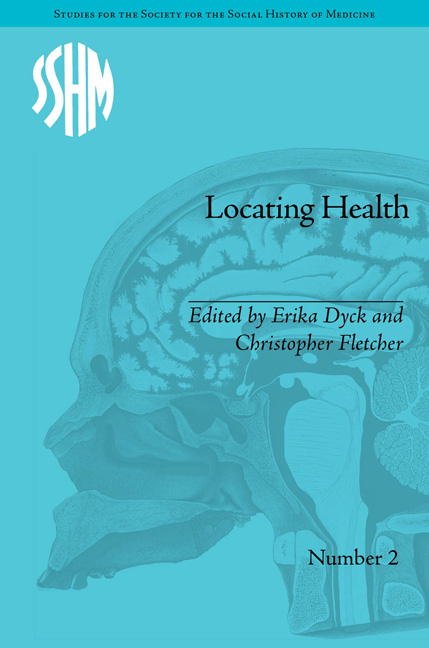Book contents
- Frontmatter
- CONTENTS
- List of Tables
- List of Contributors
- Acknowledgements and Preface
- Introduction: Healthscapes: Health and Place among and between Disciplines
- 1 Placing Maternal Health in India
- 2 Putting Medicine in its Place: The Importance of Historical Geography to the History of Health Care
- 3 Finding Place in The Big-Little World of Doc Pritham: Telling Medical Tales about Northwoods Maine, 1920s–70s
- 4 Putting Hyperactivity in its Place: Cold War Politics, the Brain Race and the Origins of Hyperactivity in the United States, 1957–68
- 5 Why Canada Has a Universal Medical Insurance Programme and the United States Does Not: Accounting for Historical Differences in American and Canadian Social Policies
- 6 Alberta Advantage: A Canadian Proving Ground for American Medical Research on Mustard Gas and Polio in the 1940s and 50s
- 7 Placing Illness in its Cultural Territory in Veracruz, Nicaragua
- 8 Chronic Disease in the Yukon River Basin, 1890–1960
- 9 An Ideal Home for the Consumptive: Place, Race and Tuberculosis in the Canadian West
- 10 Serbian Landscapes of Dreamtime and Healing: Clear Streams, Stones of Prophesy, St Sava's Ribs, and the Wooden City of Oz
- Notes
- Index
6 - Alberta Advantage: A Canadian Proving Ground for American Medical Research on Mustard Gas and Polio in the 1940s and 50s
- Frontmatter
- CONTENTS
- List of Tables
- List of Contributors
- Acknowledgements and Preface
- Introduction: Healthscapes: Health and Place among and between Disciplines
- 1 Placing Maternal Health in India
- 2 Putting Medicine in its Place: The Importance of Historical Geography to the History of Health Care
- 3 Finding Place in The Big-Little World of Doc Pritham: Telling Medical Tales about Northwoods Maine, 1920s–70s
- 4 Putting Hyperactivity in its Place: Cold War Politics, the Brain Race and the Origins of Hyperactivity in the United States, 1957–68
- 5 Why Canada Has a Universal Medical Insurance Programme and the United States Does Not: Accounting for Historical Differences in American and Canadian Social Policies
- 6 Alberta Advantage: A Canadian Proving Ground for American Medical Research on Mustard Gas and Polio in the 1940s and 50s
- 7 Placing Illness in its Cultural Territory in Veracruz, Nicaragua
- 8 Chronic Disease in the Yukon River Basin, 1890–1960
- 9 An Ideal Home for the Consumptive: Place, Race and Tuberculosis in the Canadian West
- 10 Serbian Landscapes of Dreamtime and Healing: Clear Streams, Stones of Prophesy, St Sava's Ribs, and the Wooden City of Oz
- Notes
- Index
Summary
In the mid-twentieth century, Americans turned to Canada as a proving ground to help save the lives of North American soldiers and children. To American medical researchers and government officials, the province of Alberta in western Canada provided ideal conditions for scientific experimentation in military and civilian field trials with human subjects. During the 1940s, American military personnel worked closely with their Canadian counterparts to learn from mustard gas open-air field trials and gas chamber tests conducted on more than 2,000 soldiers at the Suffield Experimental Station in Alberta. These human experiments were part of Allied preparation for potential chemical warfare during World War 2. A decade later, American scientists and leaders of the National Foundation for Infantile Paralysis invited Canadians to enrol children in a massive clinical trial in the US of the Salk poliomyelitis vaccine. The testing of over 1 million children, including approximately 50,000 in Alberta, Manitoba and Nova Scotia, was part of the battle against polio in the 1950s. How did Canada contribute to American medical research through testing in Alberta? Why was data generated in this Canadian province of interest to American researchers?
These two very different historical case studies demonstrate an American interest in the ‘Alberta Advantage’ promoted to medical researchers. They reveal some of the key themes in the history of US–Canada health relations, an emerging area of scholarship. These case studies show that in times of crisis, Canadian officials were eager to collaborate with Americans in order to save lives, offering Alberta as an ideal location for research.
- Type
- Chapter
- Information
- Locating HealthHistorical and Anthropological Investigations of Place and Health, pp. 89 - 106Publisher: Pickering & ChattoFirst published in: 2014



